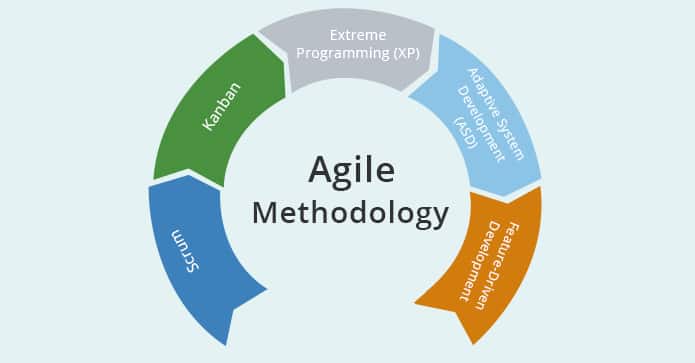Agile Methodology for Mobile App Development: A brief overview
Over the last few years, there has been a shift in the world of software development that you likely have heard of called Agile methodology.
Within Agile are multiple methodologies that all share similar principles and defining qualities such as adaptive planning, continuous improvement, and early delivery.
However, Agile methodology is still relatively unknown to the tech world. Even though close to 94% of companies use an Agile framework in some form. Some of them are still unaware of the benefits that Agile can have to them, and their organization.
In this article, we are going to break down Agile methodology and go over why we believe your business should adopt it. Let’s start.
What is Agile Methodology?
Agile takes an iterative approach to software development.
Instead of handling all the planning up front, Agile focuses on being lean and producing minimum viable products (MVP’s) over set periods of time while improving with each iteration.
The different phases of development cycle happen in parallel, and a backlog is always there to keep a track of desired features and requirements.
Agile methodologies emphasize teamwork, constant user feedback, continuous improvement, and the ability to adapt to changing needs.
Agile is a broad term that refers to any method that abides by the Agile Manifesto established on February 17, 2001.
How does the Agile Development Process Work?

The Agile development process is flexible and collaborative as design teams no longer have the luxury of taking their time bringing to market.
As the world rapidly changes, so will our technology. Thus, the agile process focuses on getting the right technology in the most efficient way possible.
There are many different frameworks which developers work with depending on the project and we are about to get into this.
As we go through them, there are few beliefs of Agile that should mention firstly.
- Individuals and Interaction -> Process and Tools.
- Working Software -> Comprehensive Documentation
- Responding to Change -> Sticking to the Plan
- Collaboration -> Negotiation
Few popular implementations of Agile Methodology are:

#1. Scrum
The scrum framework defines the uniform roles, responsibilities, and meetings that provide critical stability in an otherwise dynamic project development methodology. In Scrum, an MVP delivers every one-to-two weeks with its fast-paced sprints.
#2. Kanban
The Japenese word for visual sign or card. Kanban helps more traditional organizations improve their processes by visualizing their workflow, limiting work in progress, and enhancing the flow of backlogged items.
#3. Extreme Programming (XP)
XP emphasizes high software quality and responsiveness to changing customer requirements. Pair programming, extensive code reviews, and unit tests characterize this agile methodology.
#4. Adaptive System Development (ASD)
ASD includes repeating three-phase development cycle – speculate, collaborate and learn.
#5. Feature-Driven Development
FDD is a lightweight Agile methodology that blends some industry best practices into the five-step development cycle.
Difference between Agile and non-Agile models
| Parameters | Agile Models | Non-Agile Models |
|---|---|---|
| Approach of this Methodology | This methodology is flexible and adjustable and can adapt to the project needs. | This methodology is not as flexible as the Agile model, and it’s tough to accommodate changes in the project. |
| Measurement of Success | Success of the project is measured by the business value delivered. | Here, the success of the project is measured by the confirmation of the project. |
| Size of the Project | Project size is usually small in the Agile model, and larger projects are handled using Scaled Agile Framework. | The project size is large in non-agile models. |
| Style of Management | The style of management is not centralized. Each member of the team gets equal work. | The management style in a non-agile model is dictatorial. Only one person is the decision maker, and rest of the people follows him. |
| Ability to adapt to change | Here, changes are accepted and tailored as per project requirements. | Changes are not approved here in the later stage of development. |
| Documentation required | Less documentation is required in Agile. | More documentation is required in non-agile models. |
| Importance | More emphasis is given to people, so it’s people oriented. | More importance is given to project, so it’s process-oriented model. |
| Cycle or Iterations | Agile methodology has many cycles or iterations which is also known as sprints. | But in non-agile methodology the iterations are limited. |
| Planning in Advance | There is minimal upfront planning in agile methodology. | Here, the planning must complete before the development starts. |
| Revenue | The return on investment is early in the project cycle. | Here, the return on investment is at the end of the project. |
| Size of the Team | The team size is small and creative. | The team size is large. |
Pros of Agile Methodology
Adaptability
The short development cycles of the iterative design process give the project the flexibility to pivot as per requirements.
Test-driven development(TDD)
The beauty of breaking a project into manageable chunks is that there is enough time to write unit tests for the few features that cut MVP.
Fast, high-quality Delivery
TDD at each iteration leads to fewer bugs and higher quality releases. A solid foundation leads to quicker, higher quality releases with successive iterations.
Teamwork
Agile Methodologies emphasize frequent communication and face to face iterations. The team works together, benefit from pair programming, and interface daily with business development.
Conclusion
The need for choosing the agile methodology for mobile app development becomes an efficient approach as it delivers the various benefits over the traditional method of app development. It allows users to firmly engaged in the process, making quicker decisions all over through the process.
To match the desirable objectives, user expectations and deliver the tangible results, a mobile app development company should adopt the agile for developing mobile apps.


